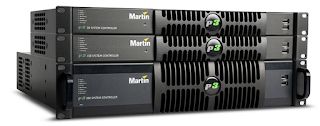 The Martin P3 processor is an amazing tool for controlling Martin creative video products such as the VDO Face 5, VDO Sceptron, and VDO Creative Pixels. I have written about the benefits before on this blog. A new feature adds incredible control possibilities when combined with a DMX lighting console.
The Martin P3 processor is an amazing tool for controlling Martin creative video products such as the VDO Face 5, VDO Sceptron, and VDO Creative Pixels. I have written about the benefits before on this blog. A new feature adds incredible control possibilities when combined with a DMX lighting console.In short, you can modify via DMX (or Art-Net) intensity, color, rotation and other parameters for each object within the P3 system. Additional system-wide controls provide easy access to presets, global intensity, color temperature, and much more. Any modifications then made via DMX override the video that is currently playing through the P3. This allows designers to create exciting imagery directly from their lighting console. In other words, the video elements become lighting elements or combination units that can do both video and lighting!
Once you have added fixtures to your P3 layout, click on the "DMX & Motion" button on the top bar of P3. This will open the DMX & Motion screen. On the left you will see a list of control types and on the right tabs for DMX, Art-Net, and K2. To configure the DMX control you need to tell P3 what you want to control and with which DMX channels. You can simply click and drag items from the left section to the right, but it is much easier to use the wizard.
 Click on the wizard button on P3's top bar to open the "DMX Control Wizard". You will be guided through several options to setup and configure your DMX control. First you can select if you want to control fixtures together, individually, in groups or other options.
Click on the wizard button on P3's top bar to open the "DMX Control Wizard". You will be guided through several options to setup and configure your DMX control. First you can select if you want to control fixtures together, individually, in groups or other options.Next you select DMX or Art-Net input and then decide what type of control you want for each.
The next screen refers to the layout of the DMX channels and asks if you want the order to be grouped by parameters or by fixture. I prefer fixture as it is easier to match up to default fixture libraries in most lighting consoles.
Finally, select the starting DMX address for your range and then click on "Create DMX Controls" to have P3 configure everything for you.
Your DMX screen will now be filled with DMX addresses assigned to their appropriate function. You can see the mapping of the DMX channel to a specific "Target" (fixture) and various other options for each channel.
Now just apply DMX or Art-Net to your P3 controller and you are ready to have fun from your lighting controller.
As mentioned earlier, you can also click and drag DMX options from the DMX screen. In the screen below I have dragged over a couple of Global Controls. These effect everything within the P3 layout. If you right click on the "Current Value" field you will see the DMX protocol (or map) for that specific channel. As you can see there are many options available via DMX control.
P3 processors provide an unprecedented amount of control and processing to the attached video devices. By adding in DMX control from a lighting console, LDs are able to further modify and use video products with ease. This ability provides additional creative possibilities not available with other systems.









